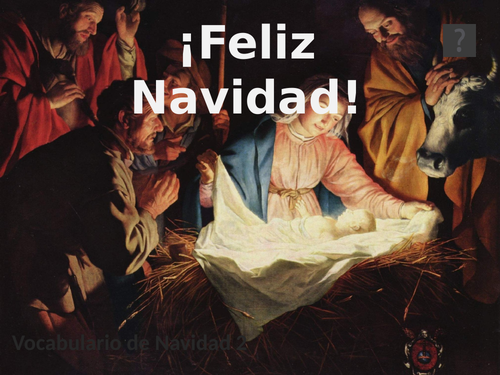





VOCABULARIO DE NAVIDAD 1 & 2
LESSON FOCUS: Christmas vocabulary with emphasis on Spanish pronunciation and spelling. Allowing students to work with the teacher or alone and to teach each other.
Depending on how you use it, it serves all ages from 7 upwards.
Primary Lesson
This is really a reading and pronunciation lesson dressed up in Christmas vocabulary.
Most Spanish lessons in primary schools are taught by class teachers with a rudimentary knowledge of the language. For those, I had attempted to add the words in voiceover but was finding it difficult to sync. I would suggest that, since there are only eight words in each video file, the teacher uses the audio on to ensure that s/he gets the pronunciation right.
As a Spanish teacher I have always found that the majority of bilingual children who learn to read in Spanish before English find learning English so much easier than a monolingual child, undoubtedly due to the phonetic characteristic of the language and the fact that Spanish children learn to read by sounding out the syllables.
When I have taught Spanish to very young children (Reception/Year 1) in English-medium primary schools I have chosen not to show them the written word which is why I say that this works best for children from the age of 7 upwards. Do it as a ten/fifteen minute presentation and practice each day for a week or so. If you have access to computers for one day, allow the children in pairs to go through the video on their own, stopping it or rewinding when necessary.
Secondary Lesson
This works better when the children have access to individual computers but can be managed in presentation form if necessary.
Divide your pupils into groups. The first group (A) watches one video, the second (B) watches the other. Then in A/B pairs they teach each other the eight words they’ve learnt.
By moving between the indefinite and definite articles (un/una and el/la) and singular and plural, this also serves to reinforce and revise their usage. You can point this out to the students and get them to change between indefinite and definite articles. There is also reinforcement of the change in spelling in some Spanish plurals to suit the sound of the word eg: luz, luces This can be used to start off a quiz/game in which the students have to write as many words as possible where this is also the case (some examples: vez, veces / pez, peces / juez, jueces / lapiz, lapices / voz, voces / a) and can link to a further discussion, either with this activity or future activities, of how the language changes its spelling to always stick to its phonetic reading:
Follow up activities for all levels
Once the children know the words they can play all manner of games in small groups or as a class using that vocabulary – they can draw the words, they can play charades to act out the words or, older children can verbally describe the words, lower levels in English, and higher levels in Spanish.
Something went wrong, please try again later.
This resource hasn't been reviewed yet
To ensure quality for our reviews, only customers who have purchased this resource can review it
Report this resourceto let us know if it violates our terms and conditions.
Our customer service team will review your report and will be in touch.
